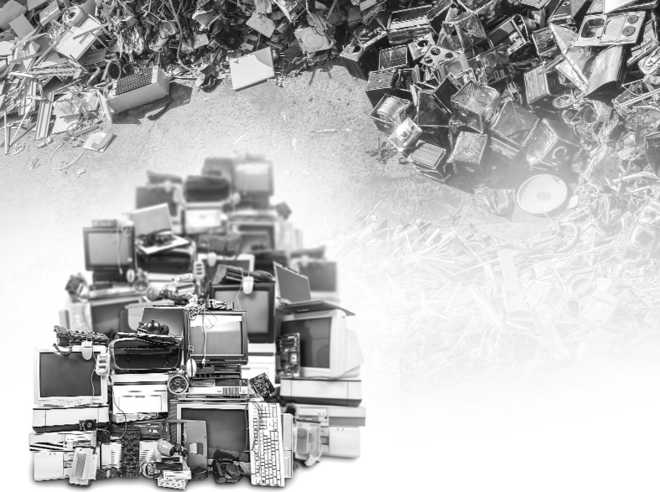
Vijay C Roy in Chandigarh
Walk around any scrap market or dealer in Punjab and Chandigarh, you would notice heaps of desktop monitors, keyboards, old TV sets and suchlike. These scrap dealers cannibalize metals off the end-of-life electrical and electronic products. Little do they know how hazardous the process can be, or the extent of damage can these metals cause to the environment.
Mobile phones & chargers, TV sets, computers and laptops have become an inevitable part of our lives. But once they are outdated or non-functional, they constitute the most discarded electronic waste. The widespread use of electronic and digital devices has made electronic waste a new environmental problem. In the absence of awareness and infrastructure support, e-waste can contaminate soil and groundwater.
The waste contains a range of metals, some of which are toxic. For instance: a mobile charger when disintegrated, has Printed Circuit Boards (PCBs), a plastic body, heat sink, condensers and transistors. Once out of use, products such as chargers are dumped in water bodies. The e-waste is also sold to scrap dealers who dismantle the items instead of recycling them. Dismantling e-waste products releases further toxic emissions in the air, causing further pollution, according to a study.
Startling figures
Last year, the United Nations reported startling figures: the world generated 44.7 million tons of electronic waste in 2016 —equivalent to the weight of some 4,500 Eiffel Towers. India’s contribution to this was a significant 2 million tons.
A study conducted by Assocham-KPMG says India has emerged as the world’s fifth largest e-waste producer. Around 2.5 million tons of e-waste is generated in India annually, of which industries and households contribute 70% and 15%, respectively. Electronic goods are responsible for about 12% of e-waste of which computers and telecommunication equipment account for 70% and 12%, respectively.
Much of the e-waste generated is recyclable. Computer equipment such as monitors and printed circuit boards have many base metals which can be reused after melting. India is highly ill-equipped in terms of both legislation and skilled labour to handle e-waste recycling. Only 1.5% of the e-waste generated in the country gets recycled. Among cities, Mumbai leads with Delhi and Bengaluru not far behind.
In Punjab…
According to a study conducted by a private agency entrusted by Punjab Pollution Control Board (PPCB), the per capita generation of e-waste in the state was 419 gm in 2012 which translates into 11,748 tons per annum. By 2021, this would be around 659 gm. Despite huge generation, the state has only one facility, Nimbua Greenfield (Punjab) Ltd based at Dera Bassi, to dismantle the scrap which started around two months back. The company dismantles e-waste and then sends it to Hyderabad for recycling.
The channelization of the e-waste for recycling and establishing a system of accountability in e-waste management is missing in the state.
“We started dismantling around two months back,” says Zorawar Singh, marketing in-charge. The facility is being operated under the aegis of M/s Ramky Enviro Engineers Ltd. The Hyderabad-based company has presence in industrial, biomedical and municipal waste management across the country. “E-waste is not coming through the organized route because of lack of awareness. People usually expect monetary benefit for their discarded electronic equipment, which is the main reason for a low volume of e-waste,” says Zorawar.
Harvinder singh, senior environmental engineer, Punjab Pollution Control Board said: “In addition to Nimbua two more units are coming in Punjab for recycling and dismantling. Once these are operational, we hope e-waste will be managed far better in the state.”
The rules
In 2016, the E-Waste (Management) Rules placed responsibility on electronic goods manufacturing companies and bulk consumers to collect and channel e-waste from consumers to authorized re-processing units.
Laws to better manage e-waste have been around since 2011, mandating that only authorized dismantlers and recyclers collect electronic waste. But now, firms are required to set yearly collection targets linked to their production numbers.
The rules also state that producers of electronic equipment must limit their use of hazardous heavy metals such as mercury, lead and cadmium. By 2017, the government hoped, manufacturers, who account for the vast majority of e-waste, would get an understanding of life under the new rules and outline targets as well as measures to collect their e-waste.
Yet despite the 2016 notification, e-waste related norms are flouted openly.
Waste disposal
There are 148 registered dismantlers and recyclers — up from 126 in 2005, as per data presented to the Lok Sabha. Together, the dismantlers handle over 4.5 lakh tons of e-waste each year
Impact on Health
- Electronic goods past their shelf-life when broken down manually/burnt or discarded in landfills, contaminate land and water
- The vast majority of electronic waste processing happens in the unorganized sector, which fills a glaring lacuna in the processing cycle
- Many workers are children who work with bare hands, dealing with enormous quantities of toxic metals. Heavy metals present in e-waste are known to cause neurological and skin diseases, genetic defects and cancer
Now, the tax
Sahil Jain, a pre-doctoral fellow at Thapar University, Patiala, says GST imposed an unwarranted 12 per cent tax on e-waste recyclers, thus compounding problems of disposal. He says it is time the government, producers and consumers joined hands to contain the damage



























